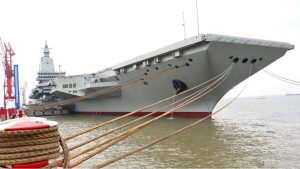
U.S. Plans 2024 Deployment of Ground-Based Missiles in Indo-Pacific to Counter China’s Military Buildup

In a strategic move aimed at bolstering deterrence against China, the U.S. military is set to deploy ground-based intermediate-range missiles in the Indo-Pacific region in 2024, marking the first such deployment since the expiration of the Intermediate-Range Nuclear Forces Treaty (INF Treaty) in 2019.
According to a spokesperson for U.S. Army Pacific, Rob Phillips, the deployment will include land-based versions of the Standard Missile-6 (SM-6) and the Tomahawk cruise missile, with estimated ranges between 500 and 2,700 kilometers. The INF Treaty, which banned land-based missiles with ranges from 500 km to 5,500 km, lapsed in 2019, allowing the U.S. to counter China’s expanding arsenal of medium and intermediate-range missiles.
While the exact deployment locations and timeline remain undisclosed, Ankit Panda, a senior fellow at the Carnegie Endowment for International Peace, suggests that the U.S. Army will primarily deploy these intermediate-range missile units to the U.S. territory of Guam. The U.S. is also considering forward deployment to Asian allies in the event of a contingency.
Guam, strategically located 4,000 km from mainland China, would serve as a critical launching point for rapid deployment to allies in response to emergencies, particularly in the Taiwan Strait or South China Sea. However, political dynamics and allies’ willingness for rotational deployments during crises remain uncertain.
Japan and the Philippines currently express reluctance to host these missiles, wary of becoming immediate targets for the Chinese military. The focus on Guam, with its critical location in the western Pacific, aligns with the U.S. military’s shift towards China and Russia, necessitating agile and mobile missile units for enhanced flexibility and deterrence.
The U.S. Army’s shift in focus acknowledges the evolving threat landscape, particularly from China, and aims to counter potential military actions. Mark Cancian, a senior adviser with the Center for Strategic and International Studies, emphasizes the need for a similar capability to counter Chinese missiles, as land-based assets can strike Chinese bases without risking ships or aircraft.
The Precision Strike Missile (PrSM), under development with a range of around 500 km, is expected to be deployed to existing Army units in Asia. Additionally, the Long-Range Hypersonic Weapon (LRHW), with a range of 2,775 km, is in its final stages of development, offering advanced capabilities in countering evolving threats.
While some experts caution that land-based assets might have a limited role in the primarily maritime geography of the East Asian context, the U.S. military’s adaptation reflects a comprehensive approach to address the multi-domain challenges posed by China in the region.














Comments